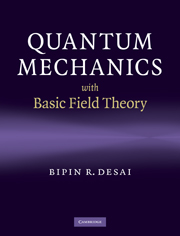Book contents
- Frontmatter
- Contents
- Preface
- Physical constants
- 1 Basic formalism
- 2 Fundamental commutator and time evolution of state vectors and operators
- 3 Dynamical equations
- 4 Free particles
- 5 Particles with spin ½
- 6 Gauge invariance, angular momentum, and spin
- 7 Stern–Gerlach experiments
- 8 Some exactly solvable bound-state problems
- 9 Harmonic oscillator
- 10 Coherent states
- 11 Two-dimensional isotropic harmonic oscillator
- 12 Landau levels and quantum Hall effect
- 13 Two-level problems
- 14 Spin ½ systems in the presence of magnetic fields
- 15 Oscillation and regeneration in neutrinos and neutral K-mesons as two-level systems
- 16 Time-independent perturbation for bound states
- 17 Time-dependent perturbation
- 18 Interaction of charged particles and radiation in perturbation theory
- 19 Scattering in one dimension
- 20 Scattering in three dimensions – a formal theory
- 21 Partial wave amplitudes and phase shifts
- 22 Analytic structure of the S-matrix
- 23 Poles of the Green's function and composite systems
- 24 Approximation methods for bound states and scattering
- 25 Lagrangian method and Feynman path integrals
- 26 Rotations and angular momentum
- 27 Symmetry in quantum mechanics and symmetry groups
- 28 Addition of angular momenta
- 29 Irreducible tensors and Wigner–Eckart theorem
- 30 Entangled states
- 31 Special theory of relativity: Klein–Gordon and Maxwell's equations
- 32 Klein–Gordon and Maxwell's equations
- 33 The Dirac equation
- 34 Dirac equation in the presence of spherically symmetric potentials
- 35 Dirac equation in a relativistically invariant form
- 36 Interaction of a Dirac particle with an electromagnetic field
- 37 Multiparticle systems and second quantization
- 38 Interactions of electrons and phonons in condensed matter
- 39 Superconductivity
- 40 Bose–Einstein condensation and superfluidity
- 41 Lagrangian formulation of classical fields
- 42 Spontaneous symmetry breaking
- 43 Basic quantum electrodynamics and Feynman diagrams
- 44 Radiative corrections
- 45 Anomalous magnetic moment and Lamb shift
- Bibliography
- Index
15 - Oscillation and regeneration in neutrinos and neutral K-mesons as two-level systems
Published online by Cambridge University Press: 05 June 2012
- Frontmatter
- Contents
- Preface
- Physical constants
- 1 Basic formalism
- 2 Fundamental commutator and time evolution of state vectors and operators
- 3 Dynamical equations
- 4 Free particles
- 5 Particles with spin ½
- 6 Gauge invariance, angular momentum, and spin
- 7 Stern–Gerlach experiments
- 8 Some exactly solvable bound-state problems
- 9 Harmonic oscillator
- 10 Coherent states
- 11 Two-dimensional isotropic harmonic oscillator
- 12 Landau levels and quantum Hall effect
- 13 Two-level problems
- 14 Spin ½ systems in the presence of magnetic fields
- 15 Oscillation and regeneration in neutrinos and neutral K-mesons as two-level systems
- 16 Time-independent perturbation for bound states
- 17 Time-dependent perturbation
- 18 Interaction of charged particles and radiation in perturbation theory
- 19 Scattering in one dimension
- 20 Scattering in three dimensions – a formal theory
- 21 Partial wave amplitudes and phase shifts
- 22 Analytic structure of the S-matrix
- 23 Poles of the Green's function and composite systems
- 24 Approximation methods for bound states and scattering
- 25 Lagrangian method and Feynman path integrals
- 26 Rotations and angular momentum
- 27 Symmetry in quantum mechanics and symmetry groups
- 28 Addition of angular momenta
- 29 Irreducible tensors and Wigner–Eckart theorem
- 30 Entangled states
- 31 Special theory of relativity: Klein–Gordon and Maxwell's equations
- 32 Klein–Gordon and Maxwell's equations
- 33 The Dirac equation
- 34 Dirac equation in the presence of spherically symmetric potentials
- 35 Dirac equation in a relativistically invariant form
- 36 Interaction of a Dirac particle with an electromagnetic field
- 37 Multiparticle systems and second quantization
- 38 Interactions of electrons and phonons in condensed matter
- 39 Superconductivity
- 40 Bose–Einstein condensation and superfluidity
- 41 Lagrangian formulation of classical fields
- 42 Spontaneous symmetry breaking
- 43 Basic quantum electrodynamics and Feynman diagrams
- 44 Radiative corrections
- 45 Anomalous magnetic moment and Lamb shift
- Bibliography
- Index
Summary
Here we consider three fascinating problems in particle physics that can be approximated as two-level systems with a somewhat phenomenological Hamiltonian. Two of them involve neutrinos and one involves neutral K-mesons. Together they provide a remarkable success story of the applications of simple quantum-mechanical principles.
Neutrinos
Neutrinos are spin ½ particles with no charge and a minuscule mass. They interact with other elementary particles only through the so-called weak interaction. Neutrinos come in three different species (called flavors): electron-neutrino (νe), muon-neutrino (νµ), and tau-neutrino (ντ) and form a part of the so-called lepton family. They are neutral accompaniments to the charged leptons: electrons (e), muons (µ), and tau leptons (τ). In the following two sections we will ignore ντ and discuss the solutions of some rather fundamental problems in neutrino physics within the framework of two-level systems.
The solar neutrino puzzle
To understand the solar neutrino puzzle we need first to note that the energy that is radiated from the solar surface comes from intense nuclear reactions that produce fusion of different nuclei in the interior of the sun. Among the by-products of these reactions are photons, electrons, and neutrinos. In the interior it is mostly electron-neutrinos, νe's, that are produced. The shell of the sun is extraordinarily dense, so that the electrons and photons are absorbed. However, because neutrinos undergo only weak interactions they are able to escape from the solar surface and reach the earth.
- Type
- Chapter
- Information
- Quantum Mechanics with Basic Field Theory , pp. 260 - 276Publisher: Cambridge University PressPrint publication year: 2009



